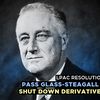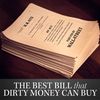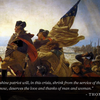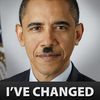21.6.2010 | 14:27
To Restore Glass Steagall: Dump Barney Frank Now!
Jeffrey Steinberg
June 21—On Sunday, June 13, 2010, Rep. Barney Frank (D-Mass.) lied through his teeth, in response to a direct challenge from Rachel Brown, the LaRouche Democrat who is challenging him for the party's Congressional nomination in the upcoming September Massachusetts primaries. Brown has focused her campaign on the reinstatement of the Glass-Steagall Act, the FDR-era law that created a wall of separation between the commercial and investment banks and insurance companies. Brown has also forcefully called for the impeachment of President Barack Obama, and for a vast expansion of the NASA manned space program, which President Obama has shut down.
Appearing together before the Brookline Democratic Club, Brown accused Frank of being one of the engineers of the destruction of Glass-Steagall, and one of Wall Street and London's key defenders on Capitol Hill.
In response to Brown, Barney lost his cool, and lied, repeatedly. I voted against the repeal of Glass-Steagall, Barney pleaded, and lied that the bill now working its way through House-Senate conference would be the strongest banking reform bill since the New Deal. Barney is going to eat those words!
About the only true thing that Barney said was that he did, indeed, vote against the Gramm, Leach, Bliley bill, the 1999 Financial Services Modernization act that repealed Glass-Steagall—but only after the House and Senate had caved in to Wall Street pressure, and passage was absolutely assured.
In fact, the House version of the Glass-Steagall repeal passed on July 20, 1999 without objection, and without any record of where individual Members of the House stood. The controversy between the House and Senate versions centered on the Community Reinvestment Act, which required banks to provide loans and banking services in low-income communities—not on the underlying issue of the repeal of Glass-Steagall.
And ever since the Nov. 4, 1999 repeal of Glass-Steagall, Barney Frank has been a powerful and consistent advocate of Wall Street interests—against the interests of the vast majority of Americans.
* In 2007, Frank, as Chairman of the House Financial Services Committee, boasted that he had played a central role in blocking any consideration of the Homeowners and Bank Protection Act (HBPA), the emergency law proposed by Lyndon LaRouche, and endorsed by hundreds of city councils, state legislatures and leading politicians and labor leaders throughout the United States, that would have put an indefinite freeze on home foreclosures, and would have placed the banking system under bankruptcy protection, under revived Glass-Steagall standards.
* In the still-ongoing deliberations on a banking reform bill, Frank blocked any House consideration of Glass-Steagall, by preventing two House bills, by Reps. Maurice Hinchey (D-NY) and John Dingell (D-Mich.) from coming up for debate and vote. Both bills were referred to Frank's Financial Services Committee, and Frank tossed them in the trash can. He also blocked the Hinchey bill from being added to the House version of financial reform as an amendment.
* Now, Frank has further lined up with Wall Street, in the effort to remove the amendment, forcing banks to divest their derivatives trading desks, that was incorporated into the Senate bill, under the sponsorship of Sen. Blanche Lincoln (D-Ark.), who chairs the Senate Agriculture Committee. The Lincoln amendment, now Title 7 of the Dodd bill, is under massive attack from Wall Street's super-banks, and Barney has made clear which side of the barricade he is on.
First, on May 21, following a meeting at the White House, Frank publicly trashed the Lincoln amendment, declaring that it went "too far," and immediately, stock prices for Goldman Sachs and other mega-banks that would be hard hit by the derivatives ban, shot up.
When a group of New York Congressmen, led by Rep. Gary Ackerman (D-NY), sent a letter to Speaker of the House Nancy Pelosi, House Majority Leader Steny Hoyer, Rep. Frank and Rep. Colin Peterson, on June 14, demanding that the Lincoln amendment be killed, Barney Frank boasted that he had encouraged the New Yorkers to keep pressing for its removal, in a June 15 interview with Huffington Post: "It's a legitimate concern of theirs, and I told them they should keep arguing."
Ackerman had flagrantly threatened to defeat the bill if the Lincoln provisions remained intact, boasting that the entire 26 Member New York delegation would defend Wall Street at all costs. "Wall Street is one of our umbilical cords, it's the oxygen," he told Huffington Post.
The darker secret that Barney Frank desperately wishes to avoid, particularly as the primary election campaign heats up, is that he has been, for the entire time he has served in the U.S. House of Representatives (since Jan. 1981), Alan Greenspan's boy toy.
A serious review of the 15-year Wall Street and City of London drive to kill Glass-Steagall tells the story that Barney is desperate to hide.
The True Story of The Bretton Woods
- JP Morgan Declares War -
In December 1984, JP Morgan, the most British of all the Wall Street investment houses, circulated an internal pamphlet, prepared by a team of inhouse economists, led by William C. Dudley. The pamphlet, "Rethinking Glass Steagall," was a clarion call for a fullscale war to break the Glass-Steagall Act, and return to the pre-FDR era of unbridled financier cartelization. At the time, Alan Greenspan was a JP Morgan director, and he would go on to be the single most important player in the takedown of Glass-Steagall.
"Rethinking Glass Steagall" was subtitled "The case for allowing bank holding company subsidiaries to underwrite and deal in corporate securities." The report summary was explicit: "Fundamental changes in our economy, important shifts in the demand for financial services, and the resulting competition among different classes of financial institutions in recent years have produced what is aptly termed a revolution in the financial services market. In this environment, competitive inequalities inherent in the rigid segmentation of the financial services industry provide another compelling reason to rethink Glass-Steagall.
"This study analyzes the major issues raised by proposals to allow bank holding company subsidiaries to underwrite and deal in corporate debt and equity securities. It first examines the arguments most commonly made to justify preservation of artificial barriers to competition imposed by Glass-Steagall and finds these arguments have little merit."
The conclusions reached by JP Morgan were no surprise: "The study concludes, and Morgan believes, that there is no valid reason to preserve the securities industry's protected position in capital markets." In other words, Glass-Steagall had to go.
- Morgan's Greenspan Takes Charge of the Fed -
Three years after "Morgan" concluded that Glass-Steagall had to be crushed, Alan Greenspan took over the Federal Reserve. In short order, Greenspan began to implement the takedown of Glass-Steagall, precisely as it was spelled out in the Morgan blueprint.
One of the tools that Greenspan employed, in illegally destroying Glass-Steagall years before the formal 1999 repeal, was the discretionary authority vested in the Fed Chairman, in a loophole, written into the Bank Holding Company Act of 1956. The bill was intended to strengthen regulation of bank holding companies, and restrict interstate banking. However, the added powers vested in the Federal Reserve Board were abused by Greenspan, to allow banks to engage in securities trading.
Prior to Greenspan's arrival at the Fed, banks were only allowed to generate five percent of their earnings from non-commercial banking activities. Through the early 1990s, according to economic historian Charles Geisst, among others, Greenspan steadily boosted the percentage, to the point that, by 1996, banks were allowed to generate 25 percent of their earnings by investment banking.
Still, however, under Glass-Steagall, commercial banks were barred from owning brokerage houses or insurance companies, despite the fact that they were allowed now to engage in significant amounts of securities marketing.
Those barriers were smashed, by Greenspan, in 1988, when he granted a waiver to Travelers Insurance Company, then headed by Sanford Weill, to buy Citibank. Travelers owned Salomon Smith Barney, a large investment bank. The Travelers-Citibank merger, thus, for the first time since the passage of Glass-Steagall, allowed a single bank holding company to own a commercial bank, an insurance company and an investment bank.
It was a total violation of the law, but Greenspan, in his zeal to kill Glass-Steagall, granted Travelers and Citibank a two-year waiver. In that two year period, Weill and company would either be forced to break up the mega-bank that had just been created—or repeal Glass-Steagall once and for all.
In the run-up to the Travelers-Citibank merger, Weill had conferred directly with Greenspan and other at the Fed, and had been assured that his efforts were totally in line with their own commitment to smash Glass-Steagall.
Weill launched a massive lobbying campaign, targeting Congress to repeal Glass-Steagall before the time ran out on the waiver. Citibank alone spent $100 million in lobbying the Congress, and other major Wall Street banks, led by JP Morgan, joined the effort.
In early 1999, both the House and the Senate introduced versions of financial reform legislation that would kill Glass-Steagall. All of the arguments, presented from the floor of the Congress, and in the backroom sessions with Wall Street lobbyists, armed with massive amounts of cash, came directly from the 1984 JP Morgan pamphlet. Greenspan had been an avid participant in the preparation of that document, and, as a Morgan director, had given his personal impremature. As Geisst told a PBS-TV Frontline interviewer several years ago, without Alan Greenspan and his role at the Fed, the repeal of Glass-Steagall would never have taken place in 1999.
The 1999 Gramm Leach Bliley Act was bought and paid for by Sandy Weill, JP Morgan, and the other big Wall Street looters. On the Hill, as the bill pushed through conference for a final vote on Nov. 4, 1999, it was commonly referred to as "the Citi-Travelers bill," or, even more personally, as "Sandy's bill."
- The Impeachment Factor -
Without Alan Greenspan's maneuverings at the Fed, Glass-Steagall could still be the law of the land today. Without the impeachment drive against President Bill Clinton, the Gramm Leach Bliley bill would have potentially gone down with the stroke of a Presidential veto pen.
It cannot be underestimated how much the impeachment of President Bill Clinton was tied to the defeat of Glass-Steagall. The targeting of Clinton was strategic, it came directly from London and London's Wall Street allies, and it had everything to do with the drive to repeal Glass-Steagall.
Beginning with the so-called Asia financial crisis of 1997, and extending through the Aug. 1998 Russian default on their GKO government bonds, triggering the near collapse of the Longterm Capital Management (LTCM) hedge fund, President Clinton, along with his Treasury Secretary Robert Rubin, came to realize that the unregulated flows of shortterm capital, brought on by the wave of deregulation, that began in the mid-1970s, shortly after the abolishing of the Bretton Woods fixed exchange rate system, was reckless and destructive, and could bring about a systemic collapse. Rubin, as Treasury Secretary, also warned, sharply against the "moral hazard" of bailing out financial institutions that were "too big to fail." His famous diktat, "not one nickel to bail out the banks," resounded on Wall Street at the time.
In Jan. 1997, Lyndon LaRouche launched an international campaign for the convening of a New Bretton Woods conference, to reconstitute a global fixed exchange rate system, and to eliminate the very speculative capital flows that were about to gut the economies of such nation-states as Malaysia, Indonesia, South Korea, Russia and Brazil, over the course of the next two years.
While it would be an exaggeration to say that Clinton and Rubin fully embraced LaRouche's plan for a return to FDR's Bretton Woods, there is no question that the impact of LaRouche's forecasts and his proposal for a revival of Roosevelt's anti-colonial policies of global economic development, were felt strongly within the Clinton inner circles.
Beginning in early 1998, Clinton and Rubin launched an international campaign to formulate a "new global financial architecture." A combination of G-7 advanced sector and G-15 emerging economy nations formed the G-22, to study alternatives to the current, unregulated global system. Representatives of the 22 nations met in Washington, D.C. in the Spring of 1998, and established a series of ongoing working groups, to come up with plans for a new, more regulated international financial system.
These moves by Clinton and Rubin stood in stark opposition to the Greenspan-JP Morgan-Sandy Weill drive to bust up the last vestiges of restrictive bank regulation in the U.S.A.
When, in Sept. 1998, President Clinton traveled to New York City, to deliver a speech before the Council on Foreign Relations, pressing for a "new global financial architecture" with far greater regulation and restriction of shortterm capital flows, all hell broke loose. Clinton was targeted for impeachment. Wall Street Democrats, led by Vice President Al Gore and Sen. Joe Lieberman (D-Ct.), joined with Britain's Daily Telegraph propaganda mill, to press for Clinton's resignation. The House of Representatives voted a bill of impeachment.
The issue was never the Monica Lewinsky affair. The issue was President Clinton's publicly announced commitment to overhaul the global financial system, to the detriment of speculators.
And the punishment was swift. From the time that President Clinton delivered his statement of intent to overhaul the global financial architecture at the CFR in late September, to the time that the House of Representatives voted for his impeachment, took less than 90 days. The City of London's demands for Clinton's scalp over his threat to reregulate the global financial system—in cooperation with developing sector countries that had been viciously looted by speculators—was delivered.
There was never a serious question about the outcome of the impeachment trial of President Clinton in the U.S. Senate. The Democratic majority was never about to vote up the articles of impeachment, despite the Gore-Lieberman efforts to seize the Oval Office. On Feb. 12, 1999, the Senate acquitted Clinton.
But the die had already been cast, and the drive for the repeal of Glass-Steagall benefited enormously from the Clinton impeachment distraction, which killed off any efforts at the new global financial architecture. On May 12, 1999, Robert Rubin resigned as Treasury Secretary, effective July 1 of that year. His replacement, Larry Summers, was fanatically committed to "Sandy's law," repealing Glass-Steagall. On Nov. 4, 1999, both the House and the Senate passed the Glass-Steagall repeal. A broken and distracted President Clinton signed it into law days later.
http://www.larouchepac.com/lpactv?nid=14906
Flokkur: Stjórnmįl og samfélag | Facebook
Um bloggiš
Amazing Iceland and Icesave
Nżjustu fęrslur
- Washington Represents the Most Concentrated form of Evil in H...
- F William Engdahl - Totalitarian Democracy in the New World O...
- Ķ tilefni jįtningar Tony Bliar
- Washington's Path to War with Russia
- Obama Places World on Fast Track to Thermonuclear War
- State of the Union - Lyndon LaRouche - Jan 18, 2012
- Thanks for arriving early!
- Banned incredible Ron Paul Video
Fęrsluflokkar
Tenglar
Pólitķk
Stjórnmįl og kosningar 2007
- HJARI VERALDAR
- Inspired by Amazing Iceland Amazing Videos from Iceland
- FREE Iceland Crash Book Iceland Crash Enslaving a Small Nation. The Brutish Empire strikes again.
- ICALAND ECONOMIC DISASTER
- GLOBAL GLASS STEAGALL Saving the Planet Now!: A Global Glass Steagall
- Iceland Crash ! Vefsķša į ensku um hruniš į ķslandi
- Kvótagreifarnir Kvótabófarnir sem öllu rįša!
- Wordpress Stjórnmál My Wordpress Blog. Iceland Crash
- Freedom Burma. Restoration AUNG SAN SUU KYI er eini Nóblesveršlaunahafi ķ fangelsi !
Góšir Linkar
Įhugaveršir Linkar fyrir feršamenn,og ašra sportmenn.
- Silencer Brake Combo Gun silencer and gun Tech Books and accessories for rifles and pistols
- Heimasíða Rifflar BRS Custom Rifles Custom rifles precision made. Hunting and target rifles.
- Glass Bedding Rifles Leišbeiningar um hvernig į aš bedda riffle
- Custom Rifles Blog Custom Rifles, Gun silencer blog
- Double Action Brake Silencer og Muzzle Brake Combo.
- Síðan Mín ! How to make a gun silencer
- Gun Silencer How to make a gun silencer
- Amazing Iceland Video Collection
- GOOGLE PRECISIONGROUP
- MSN Precisiongroup
- YAHOO PRECISONGROUP
- Amazing Iceland !
- B.R.S. RIFLES BLOG
- TOOL DESIGN !
- RIFLEPRO BLOG !
- MSN RIFLEPRO SPACES
- Betri Rifflar !
- NÁTTÚRU VIDEO GOOGLE
- TOOLPATENT !
- VIDEO VERSLUN.
Bloggvinir
Heimsóknir
Flettingar
- Ķ dag (19.9.): 0
- Sl. sólarhring: 2
- Sl. viku: 8
- Frį upphafi: 0
Annaš
- Innlit ķ dag: 0
- Innlit sl. viku: 8
- Gestir ķ dag: 0
- IP-tölur ķ dag: 0
Uppfęrt į 3 mķn. fresti.
Skżringar

 gammon
gammon
 bofs
bofs
 lovelikeblood
lovelikeblood










Bęta viš athugasemd [Innskrįning]
Ekki er lengur hęgt aš skrifa athugasemdir viš fęrsluna, žar sem tķmamörk į athugasemdir eru lišin.